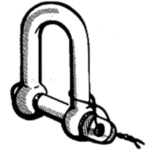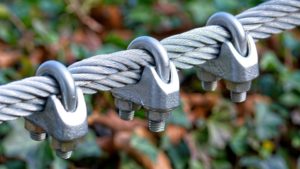Shackles, Clips, and Slips

Shackles
- A shackle is a U-shaped fastening device secured by a bolt or pin through holes in the end of the two arms. It is used as a connecting device.
- Shackle pins can be threaded or non-threaded. In marine environments, threaded shackle pins are the most common.
- The two main types of shackles are anchor shackles (shown in the top right photo) and chain or D shackles (shown in the bottom right photo). Anchor shackles are better at handling multi directional forces or other non-inline forces. D shackles are better at handling inline forces.
- Threaded shackle pins may be tightened or loosened with significant force by using a marlin spike or wrench on the pin.
- If the shackle is meant to be used as a long term connector, it should be moused.

- Mousing a shackle means that the pin should have wire that runs through it looping from the pin to the inside of the shackle in order to prevent it from backing off.
- If the shackle is used to attach to a standing portion of line, keep the pin end away from standing portion of line. Rubbing against the standing portion of line may either overtighten the pin or back it off.
- The SWL of the shackle should be stamped on the exterior of it.
Kenter Shackles
- These are stud links that come in three parts. They can be opened by removing a diagonal pin that runs through the stud and the other two parts of the shackle.
- These are used for connecting chains or replacing faulty links.
- Commonly found in anchor chains to visually represent a “shackle” of chain (15 fathoms or 90 feet).
- When installing or maintaining joining shackles on an anchor chain, it’s important that the bow of the shackle points towards the anchor.
Clips
- Clips are used to attach two sections of wire rope together.
- Clips are commonly used in combination with thimbles to make hard eyes in wire rope.
- The golden rule when using clips to attach two pieces of wire rope is to “never saddle a dead horse”. This saying refers to the saddle of the clip (the thicker portion) and how it should always be placed on the standing end of the wire rope and not the working end. When clips experience tension high enough to cause them to slip, they tend to slip on the saddle side (as opposed to the U bolt side).
- Be sure to tighten clips in an even manner such that the number of threads exposed on either side is similar and the U bolt isn’t lopsided.
- Ensure when using clips that they are the right size for the diameter of cable. A mismatch in clip size will be more prone to slippage.
- Commonly tightened with impact equipment.

Slips
- A slip is a tool used as a fastener that can be undone even when under tension.
- One of the most common among these is the Senhouse slip shown in the picture to the right. To release the slip a person would squeeze the eye enough to let the ring free, slide the ring upwards, and then release the pressure from the eye and thereby freeing the line passing through it.
- Senhouse slips are commonly found in cable railing aboard ships and in securing liferafts. Especially in the case of a liferaft, being able to manually release a tight cable is preferred, hence the use of the slip.
